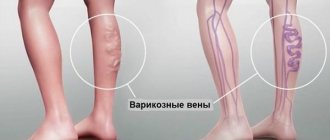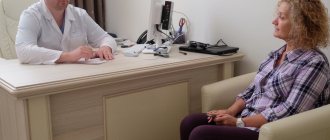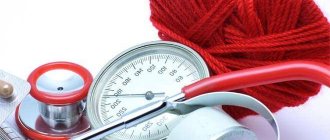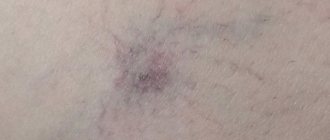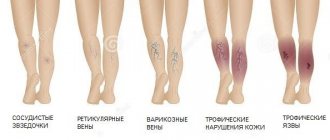A separate area on my leg hurts. The skin is thick, hot, marble-white. Suddenly there was a high fever, weakness and severe swelling of the leg. Accompanied by cold-like symptoms, but antibiotics do not help...
Phlebitis is an inflammation of the walls of a vessel, which leads to the gradual destruction of the vessel completely. The danger of the disease lies in complications due to the patient’s lack of desire to seek medical help.
The appearance of blood clots (thrombophlebitis), blockage of veins, thrombosis, abscess - these are the consequences of lack of treatment. To avoid them, listen carefully to your own body. He will definitely indicate the first signs of the disease. A qualified specialist, a phlebologist, will help determine the disease.
It is important to see a doctor at the first symptoms. Timely help will help you get rid of phlebitis, possible complications and causes of the disease almost without a trace. Let's figure out how to recognize and treat phlebitis in time.
Causes
For thrombophlebitis to occur, one or more of three factors must be present (the so-called Virchow triad):
- Damage to the vein wall (can be either mechanical, due to injury, or chemical - a burn from the administration of concentrated drugs, narcotic substances)
- Violation of the rheological properties of blood (increased coagulability, viscosity, etc.). This happens with dehydration, certain diseases, hormonal, and genetic disorders.
- Slowing of blood flow in the vein (when the vein is compressed, movement is limited (for example, when wearing a plaster cast)).
Under the influence of one or several factors, a blood clot forms in the lumen of the vessel and inflammation of its wall occurs. Example: with a serious leg injury, all three factors are present - mechanical damage (tears in the vein wall due to an impact), increased coagulability (due to blood loss), slowdown of blood flow (tissue swelling, plaster application).
Usually, with thrombophlebitis of the superficial veins, one vein is affected; inflammation can also spread to its tributaries. Migrating thrombophlebitis is known - with it, sequential inflammation of several veins occurs in different parts of the limbs. Such thrombophlebitis requires additional diagnostics to exclude oncological processes or genetic coagulation disorders.
Doctor, what's wrong with me?
If your legs (or one leg) are swollen and red, we recommend consulting a doctor.
Especially if swelling occurs regularly. According to experts, swelling is not the norm. Even if you stand on your feet all day and are tired, the presence of recurring swelling still indicates certain problems. Do not self-medicate, especially if you notice redness and pain on your leg. This condition may be the result of an injury that you did not pay attention to at first. Or it may indicate the presence of a serious illness (including thrombophlebitis), for which it is necessary to receive professional medical help as quickly as possible. There may be several reasons for swelling and redness of the leg.
Symptoms, diagnosis
Diagnosing thrombophlebitis of the superficial veins is usually not difficult. Patients complain of pain, a painful compaction in the form of a “cord” in the projection of the saphenous vein. The skin over the lump is often hyperemic (redness). There may be a slight increase in body temperature. Most often, varicose veins become inflamed. There are frequent cases of phlebitis after intravenous injections. Thrombophlebitis may occur without any apparent reason. In this case (and especially with recurrent, migrating thrombophlebitis), a genetic analysis for thrombophilia and exclusion of oncological processes is needed.
Of the additional research methods, ultrasound (duplex angioscanning) is of greatest importance. In doubtful cases, it allows you to accurately make a diagnosis, as well as identify complications (transition of phlebitis to deep veins, etc.).
Laboratory methods have little diagnostic value - a slight increase in leukocytes and ESR in a general blood test is possible. There are usually no changes in the coagulogram (clotting test). Laboratory diagnostics becomes important for recurrent and migrating thrombophlebitis - in this case, coagulogram abnormalities can be detected, as well as changes in genetic analysis.
In itself, thrombophlebitis of the superficial veins is not dangerous - thromboembolism (separation and migration of a blood clot into the pulmonary artery) never occurs with it. Only ascending thrombophlebitis of the trunks of the small and great saphenous veins is dangerous. In this case, phlebitis can spread up the vein, and, upon reaching the place where the superficial veins flow into the deep ones, spread to them, which can already be fraught with thromboembolism.
Treatment of varicose veins on the legs
Varicose veins - when hearing these words, everyone usually imagines blue nodes on their shins. But in fact, it is not only the legs that suffer from this disease. There are varicose veins of the esophagus, epididymis, pelvic organs and other organs. Although the most common is indeed varicose veins of the lower extremities.
Varicose veins are pathological dilation and tortuosity of superficial venous trunks, leading to dysfunction of the vein. What exactly is the function of a vein? Let's remember the school course on human anatomy. There is an immutable rule in our body: blood flows from the heart through the arteries, and to the heart through the veins, remember, right?
Let's continue. As you again know from the school curriculum, blood flows to the organs thanks to the power of our cardiac motor. And for blood flow in the opposite direction, a second heart is connected - skeletal muscles. That is, with physical effort, the muscles rhythmically (or non-rhythmically) compress the veins along with the blood and a current occurs. It is important that thanks to the venous valves, the blood moves in one direction (you can go there, but you can’t go back).
Why do veins dilate?
In the legs, in the thickness of the muscles, the main veins lie; the overwhelming volume of blood normally flows through them. At the same time, if you look at your legs (legs), you will see thin, barely noticeable venous plexuses on the surface. These small veins connect to deep, great vessels.
Everything goes well until factors appear that provoke excess pressure in the venous system of the extremities. This:
- firstly, pregnancy - when a large uterus compresses the vessels of the lower extremities - or high blood pressure during childbirth;
- secondly, taking hormonal drugs to avoid pregnancy (or for therapeutic purposes);
- thirdly, a sedentary lifestyle.
Also provoking factors are chronic constipation, causing increased pressure in the abdominal cavity, carrying heavy objects, standing work in salespeople, hairdressers, surgeons and other specialists.
Question: who gets sick more often? That's right - women. Why? And take another look at the risk factors, guess what? However, along with this fact, a hereditary predisposition to varicose veins has long been proven, apparently associated with the structure of the vascular wall. Therefore, not all women who give birth and spend a lot of time on their feet develop varicose veins of the legs.
High pressure in the venous system of the lower extremities requires the release of this pressure, and since the diameter of the deep veins is limited by the muscles, the blood flows to the superficial veins, where there is no muscle corset and a weak vascular wall. As a result, the superficial veins dilate.
Serious complications of varicose veins
Remember at the beginning of the article I talked about valves that help the muscular system push blood through? They operate on the principle of a reed valve. In venous vessels, the petals are directed towards the blood flow, and when the vessel expands excessively, a hole is formed between the petals, which allows blood to pass back and forth, which is how valve insufficiency occurs.
As a result, the blood stagnates in the legs, the liquid part of the blood flows into the tissues, and the legs swell. Edema tissues compress arteries, blood supply is disrupted, this leads to local tissue necrosis and trophic ulcers are formed. I may have explained it too simply, but I think the mechanism of what is happening has become more or less clear to you.
How does the disease progress?
The first symptoms: after a long period of sitting or standing, heaviness in the legs, swelling, and a feeling of fullness appear. At first, this is easily treated with a regular walk or sleep.
Then bursting pain begins, and at night - unpleasant painful cramps in the calf muscles. All this is the result of a lack of oxygen in the tissues. Then spider veins appear, veins come out, writhing, they form ugly bluish clusters.
Further (if not treated), inflammation develops in the area of varicose veins of the leg, up to the formation of ulcers with deep vein thrombosis and a real risk of pulmonary embolism.
What can be done to cure it?
There are two ways. The first is a conservative method. This is when I took a pill in the evening, and in the morning my veins fell off (just kidding). But seriously, first of all, wearing special compression hosiery and physical therapy are indicated. And tablets, suppositories and ointments only remove the external manifestations of the disease - pain, swelling, and improve tissue blood flow.
The next two methods are more optimal, but require the intervention of a professional - a phlebologist surgeon. However, even an ordinary surgeon can handle this.
So, the first method is sclerotherapy. In this case, a substance is injected into the subcutaneous vein that causes the vein to stick together. Actually, that’s all - no blood flow, no pressure, no varicose veins. The only problem is that I have never seen even one of our patients undergo such a procedure. We read about it on the Internet, but don’t see it.
But this does not mean that this is not being done in Russia. It is done, but in specialized clinics. By the way, patients abroad are treated almost 100% this way, which is quite justified. Sclerotherapy is a minimally invasive, painless operation with a minimum of complications and a short postoperative period.
Well, in our clinic, surgeons work using the second method - they simply cut out the damaged veins “from the roots”, tie off their connection with the deep veins, and that’s all. No vein - no problem. After some time, the patient becomes healthy. Also, let me tell you, it’s a good option.
Vladimir Shpinev
Photo istockphoto.com
Products by topic: (anti-varicose knitwear), (venotonic and venoprotective agents)
Treatment of phlebitis
Thrombophlebitis should be treated by a doctor (surgeon or phlebologist). Along with treatment, the doctor must monitor the patient so that if there is a threat of phlebitis spreading to the deep veins, the patient can be hospitalized in a hospital in a timely manner.
The patient is advised to rest, although bed rest is not necessary.
Several groups of drugs are used to treat uncomplicated thrombophlebitis:
- Non-steroidal anti-inflammatory drugs (Voltaren, Nimesil, etc.)
- Phlebotonics (detralex)
- Antiplatelet agents (thrombo-ASA)
- Local products containing heparin (Lioton-gel).
Drugs that directly affect blood clotting (anticoagulants) are usually not used for thrombophlebitis of the superficial veins, although in some cases (with recurrent, migratory thrombophlebitis) their use is possible.
It is a mistake to prescribe antibiotics - inflammation in thrombophlebitis is almost never microbial. Purulent thrombophlebitis is a very rare phenomenon; it can develop after injections with non-sterile syringes or after injuries that violate the integrity of the skin.
If there is a threat of transition of phlebitis from superficial to deep veins, an emergency operation is performed - ligation of the affected vein, which prevents further spread of the process. The intervention is performed in a hospital.
Acute inflammatory phenomena (pain, redness) usually subside within a week, and a blood clot in the lumen of the vein resolves within a few weeks.
Symptoms of phlebitis
In acute and chronic phlebitis of the superficial veins, the inflamed vein is tense and painful. The skin on the leg is tight, hot and red. Red stripes appear along the vein.
With acute and chronic phlebitis of the deep veins, the patient's temperature rises. The skin over the damaged area becomes thin and red. A red stripe appears along the inflamed vessel. The limb swells and hurts. The patient feels weak in the body.
Cerebral phlebitis is an inflammation of blood vessels leading to the destruction of venous walls. Characterized by weakness, high blood pressure, dizziness, prolonged and frequent headaches. The inflamed area becomes numb.
Pylephlebitis is a purulent inflammatory process in the veins. The disease is indicated by: weakness, prolonged fatigue, fever with chills, abdominal pain, vomiting, headache, poor appetite and insomnia. The symptoms are similar to a cold. Sometimes pylephlebitis provokes bleeding from the stomach or intestines. Therefore, if you feel that the symptoms are not typical of a cold, then contact a phlebologist for an examination.
Joint disease
Some joint diseases are accompanied by swelling and redness of the skin in the area of the affected joint. If it is a chronic disease, then patients know about it and pay attention. But there are also injuries that manifest themselves with these symptoms.
Joint injuries are always accompanied by pain. If it is not strong, if the joint is not swollen and its contours are not changed, you can bandage your leg with an elastic bandage and consult a doctor. If the pain is severe and does not go away with rest, if the joint is deformed, the leg is very red and swollen, this indicates that you should seek medical help immediately.
"Cardiac" edema
With diseases of the cardiovascular system, in particular with heart failure, swelling also occurs, which in some cases may be accompanied by redness of the legs. In this case, swelling increases if it is hot outside, if a person spends a lot of time on his feet. But at rest the swelling subsides. The leg in the area of swelling is soft to the touch.
Interestingly, cardiac edema can go away on its own if the heart function improves at some point or the patient reduces the level of activity. However, their appearance indicates that you need to contact a cardiologist.
